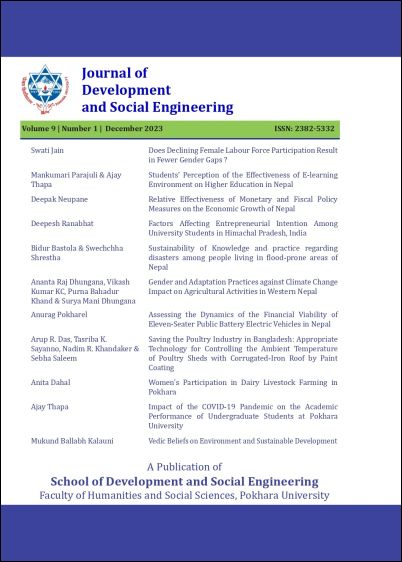Relative Effectiveness of Monetary and Fiscal Policy Measures on the Economic Growth of Nepal
DOI:
https://doi.org/10.3126/jdse.v9i01.70557Keywords:
Cointegration, convergence, economic growth, stabilityAbstract
This study assesses the long run and causal relationship of various monetary and fiscal policy measures with the economic growth of Nepal. Annual time series data from the fiscal year 1976/77 to 2021/22 are used and analyzed employing econometric method of cointegration and Vector Error Correction Model (VECM) for the assessment and draw inferences applying r programming. All the variables exhibit stationarity at first order difference and are co-integrated. In the long run, monetary policy measures, broad money supply has the negative relation but interest rate and exchange rate have the positive relation with the economic growth. Fiscal policy measures under consideration total revenue, total expenditure and total trade are negatively related with the long run economic growth. However, neither the fiscal nor the monetary policy measures indicate the significant relationship with the economic growth in short run. The negative and significant coefficient of Error Correction Term (ECT) suggests the convergence of variables towards long term equilibrium. The cumulative sum (CUSUM) tests indicate the stability of the coefficients in the model, and the diagnostic tests reveal the absence of serial correlation and heteroscedasticity in the model. Finally, Granger causality test shows the existence of causal relationship between the independent and dependent variables. This study concludes the existence of long run relationship of monetary and fiscal policy measures with the economic growth in Nepal and monetary policy measures appear to be relatively effective than that of fiscal policy measures in stimulating the economic growth of Nepal.
Downloads
Downloads
Published
How to Cite
Issue
Section
License
Copyright © Journal of Development and Social Engineering, School of Development and Social Engineering, Faculty of Humanities and Social Sciences, Pokhara University. All rights reserved. The School of Development and Social Engineering, Pokhara University holds the exclusive copyright of all the contents of this journal. No part of this journal may be reproduced or transmitted by any media or publishing organizations including websites without the written permission of the copyright holder. The contents of this journal are available for any citation, using a recognized and proper referencing system.




